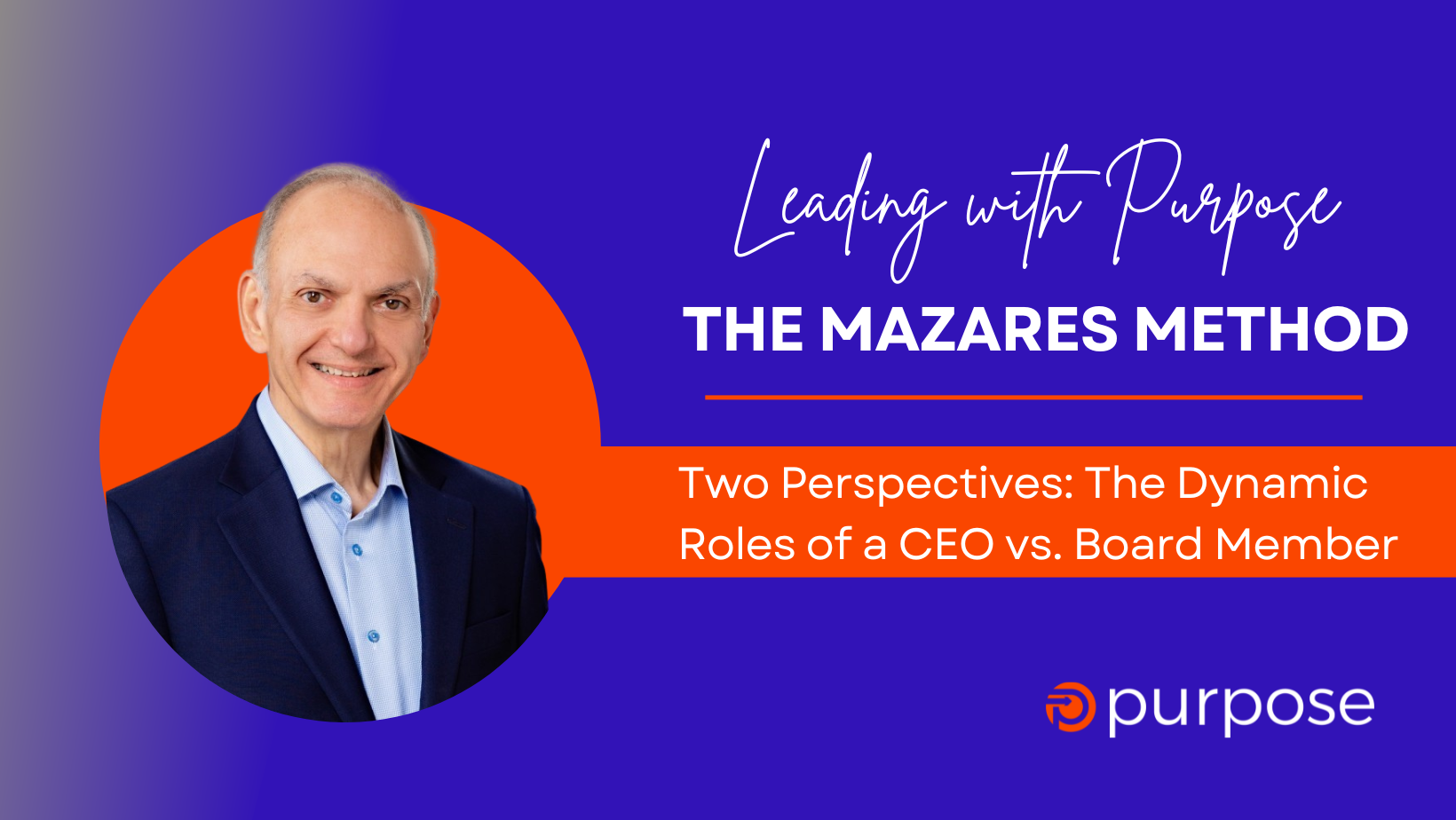Rather listen than read? Play the audio below
One of my colleagues who knows that I am currently CEO of Purpose Legal, and also serve on the Boards of two other companies, asked me about the differences between being a CEO and a board member.
Certainly, operating a company as CEO and contributing as a member of the Board of Directors are two very different roles within an organization. While both positions involve leadership, strategy, analytical skills, and decision-making responsibilities, they require distinct skills and areas of focus.
Most board members are seasoned, proven executives (or former ones), while not all CEOs are experienced or effective at the job. After all, all CEOs share the experience of having been a “first-time” chief executive. As a case in point, often times entrepreneurs who become founders of new companies have never run a business before, but are bright, talented, and open to learning the role. Remember Steve Jobs, Bill Gates, and many other prominent CEOs were not great executive leaders right from the start. Additionally, some of the brightest business leaders have absolutely no “bedside manner” and they are extremely hard to be around every day. (Remote work: what a blessing).
As a CEO, I am responsible for the day-to-day leadership of the company. The CEO holds ultimate decision-making authority over all aspects of the business (unless the issue is so critical or risky that Board input and sign-off is necessary). Good CEOs delegate decision-making, within parameters, to members of their leadership teams. A CEO who feels the need to make every business decision generally becomes part of the problem rather than part of the solution. Let’s remember, the CEO is accountable to the Board of Directors and shareholders for the company’s performance and is tasked with ensuring the company’s long-term growth, bottom-line performance, and sustainability. Business schools preach that the CEO’s job is to “maximize shareholder value.”
In contrast, serving as a member of the Board of Directors (or as a non-voting Board Advisor) is much more of an advisory role. The Board of Directors is responsible for providing guidance, oversight, and governance of the company’s activities. Directors are elected by shareholders and typically have extensive experience in the company’s industry and expertise in key functional areas including sales/marketing, finance, or technology development. The most impactful Boards I have seen are comprised of individuals with complementary skills and strengths. The Board of Directors sets the strategic direction of the company, approves budgets and major financial investment decisions, and monitors the performance of the CEO and senior leadership team versus objective business goals.
While the CEO is focused on developing and executing the company’s competitive strategy and driving day-to-day operational performance through motivating people and enhancing the corporate culture and work environment, the Board of Directors is focused on governance, risk management, and ensuring that the company is operating in the best interests of its shareholders. Board members provide independent oversight of the company’s activities, review financial and operational performance, and make strategic decisions that impact the long-term success and reputation of the organization and its brand(s).
In terms of decision-making authority, the CEO has the ultimate responsibility for executing the company’s strategy and achieving its financial goals. The CEO reports to the Board of Directors (generally to the Chairman) and is accountable for, among other things, the company’s quarterly and annual performance versus budget. Board members, on the other hand, make decisions as a collective body, with each member bringing her/his unique perspective and expertise to the table. In many companies the CEO is also a member of the Board. NOTE: I am not currently a member of the Board of Purpose Legal. I think that’s the right decision. Among other reasons, I haven’t been with the Company long enough to earn the trust of the Board through performance/results. Interestingly, in the two companies where I am a Board member, both CEO’s are also Board members.
One of the Board’s main roles is to monitor the operations of the business and to ensure that it is being run in concert with the mandate of the company and the will of its shareholders. As the CEO holds the senior management position responsible for driving those operations, having a combined role results in “monitoring oneself,” which at times can lead to abuse of the position. A Board led by an independent chairman is more likely to identify and monitor areas of the company that are drifting from its mandate and to put into place corrective actions to get it back on track. For this reason, I am very much in favor of separating the CEO from the Board Chairman. Everyone needs to be accountable to someone else, as my darling wife constantly reminds me. (NOTE: I have lovingly nicknamed her “The Chairwoman.”)
While both roles involve leadership and decision-making responsibilities, running a company as a CEO and serving as a member of the Board of Directors are fundamentally different positions within an organization. Again, the CEO is responsible for the day-to-day operations and strategic direction of the company, while the Board of Directors provides oversight, governance, and strategic guidance to ensure the company’s long-term success. Understanding the distinctions between the two roles is crucial for individuals seeking to navigate the complexities of corporate governance and leadership. In the fifth decade of my business career, I am so very fortunate and honored to be able to serve in both roles for different, non-competitive companies.



